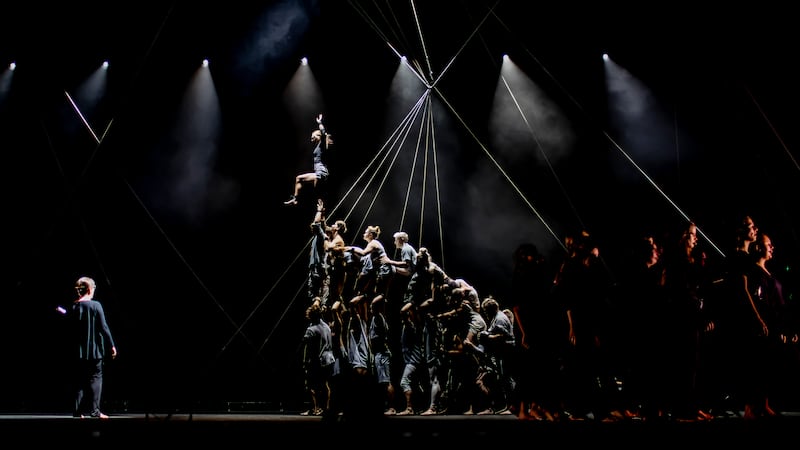On a warm, cloudy evening in Barcelona, a group of athletes gather in Teatre Grec, a 100-year-old amphitheatre built in ancient Greek style. It’s an unlikely setting for a contemporary circus to practice before their show, and the prevalence of acrobats looking akin to the physiques of Greek gods presents a scene closer to Gladiator than Cirque du Soleil.
As athletes practise backflips and effortlessly standing on each other’s shoulders, a backstage crew carefully remove a sticky plastic covering on stage and furiously hoover carpets now exposed for the first time. The stage preparation is careful and deliberate.
There is an intense camaraderie and playfulness about the group as they practice complex acrobatic sequences – but for what these guys are about to do, there’s no way they aren’t nervous.
“We’re excited but we’re also terrified,” says Darcy Grant, the artistic director of The Pulse, a “circus meets dance meets opera” show hailing from Adelaide, Australia. “But as my father says: ‘You’ve gotta have the fear.’ We do, and I think that’s what keeps us sharp. I think complacency is the enemy of an alive show – a living show.”
From Baby Reindeer and The Traitors to Bodkin and The 2 Johnnies Late Night Lock In: The best and worst television of 2024
100 Years of Solitude review: A woozy, feverish watch to be savoured in bite-sized portions
How your mini travel shampoo is costing your pocket and the planet - here’s an alternative
I’m meeting him along with two other members of the circus company, Gravity & Other Myths, or “Gom” for short, at a nearby hotel in advance of the show’s first performance for an international tour. The show was showcased at last year’s Edinburgh Festival, prompting an international tour of Barcelona, Montreal, Galway and Austria.
As the coronavirus pandemic shut down life down under, Gom artists were given the opportunity – with the help of some government funding – to develop an ambitious show, larger than they had ever tried before. At the core of the project is the question of what a large collective of acrobats can achieve when working on one big show, instead of disparate smaller ones.
“We were maintaining three full-time touring ensembles and suddenly that all got shut down [due to the pandemic], and all 30 of our artists ended up back in Adelaide,” says Grant. “That led to an absolute explosion of skill level.”
Through acrobatics and various dance styles, The Pulse sets about mimicking natural systems bigger than the individual – but still keeping that unique touch from the performer.
“One of the scenes in the show is called murmuration: it feels like many particles or a flock of birds moving around in these cyclic looking things,” Grant says, adding that galaxies and solar systems is another one. The ideas are all in there, and it’s up to the audience to interpret it.
At rehearsals before the show in Barcelona, some dancers are shouting out calls to practice different arrangements, such as The Parachute or The Yolo sequence. Even without the music and lights, they’re a sight to see.
Their members come from backgrounds in gymnastics, contemporary dance, breakdance, ballet, martial arts, rock climbing and clown relief. There’s no star of the show, so everyone gets a chance to show off their unique talent as they share the spotlight.
“Every single person in the creative space has the ability to inject their personality – the things their good at, the things their body type allows us to do – into the show,” says Lachlan Binns, a director and acrobat at Gom. “All those things filter their way through, and you can see those sparks of individuality.”
Jascha Boyce, another Gom director and acrobat, says: “Even with a work of this scale, with 60 people on stage, we still do find ways to have personal connections with the audience and really try and let them into our world rather than having a fourth wall of any kind.”
Back at the Teatre Grec, Grant gives his final pep talk before the crowds arrive for the opening night of the Festival Grec de Barcelona 2023. He always feels nervous on the day of a show, he later tells me.
“I’m a washed-up acrobat myself,” he says, having performed in Galway three times with a circus. “There’s something about living life vicariously. Maybe there’s something addicting about it.”
The designer of the show says his ultimate goal is to inspire existential awe, and nothing inspires that more than a thunderstorm
— Darcy Grant
As the team clears off the stage and the audience get seated, a sea of fans beat away the hot evening air. Some frequent lightning in the distance illuminates the dark sky, but it doesn’t seem to bother locals. The show begins.
A lone woman appears on stage and counts to three, on repeat, in Catalan. She is the first of the 30-strong Orfeó Català choir we see. Soon she is mirrored by a lone acrobat staring back, before breaking into aimless walking with acute and sporadic turns. Their efforts are doubled as more join in their actions. More counting, more walking. A loud chorus of incessant jibber-jabber ensues. It’s not quite clear what’s going on, but the almost ethereal backing of the choir creates a feeling of some greater meaning alluding the viewer.
Soon a flurry of leaps and drastic movements are executed, all to the soundtrack of a heavenly chorus – whatever antics are unfolding, us mere mortals aren’t meant to understand. The approaching lightning storm in the amphitheatre’s periphery adds to the sense of a greater power, although it’s not clear if such weather events are guaranteed in Galway.
Two groups of multiple three-person high towers walk through each other without touching – a feat prompting gasps and applause from a keen Spanish audience.

“You can get four-six metres high,” says Binns beforehand. The Catalans are no strangers to getting up there with their famous castell towers, but the Aussie acrobats are somehow achieving similar heights without large crowds to brace them.
One impressive sequence presents the audience with a series of successive, purposefully failed manoeuvres. Then the rain arrives.
It is light at first and adds an epic quality to the existential visual opera unfolding in front of the audience. In a tonal shift, one performer gives a rendition of Mary Had a Little Lamb exclusively through the howls of fellow dancers as he jumps on their lifeless bodies in sequence. A refreshingly bizarre comic event, which soon reverts into acrobatic antics and waves of a cappella.
But as the rain worsens, Grant walks on stage and creates an “X” with his arms towards the dancers. After a little more than 30 minutes of the 70-minute show, it is called off due to the weather. They receive a standing ovation.
Crews rapidly cover the equipment and remaining carpets. Some audience members hope for the rain to stop and get their money’s worth, but most cut their losses and head home.
In the gardens adjacent to the amphitheatre, the choir soon emerges to sing for the disappointed crowd that chose to stick around for a while. Grant emerges alone to witness the spontaneous happening: “The show must go on” rings true.
“We just experienced a rain stoppage,” he tells me under the waning thunderstorm. “The circumstances of that stoppage were pretty magnificent. The designer of the show says his ultimate goal is to inspire existential awe, and nothing inspires that more than a thunderstorm.”
[ Galway International Arts Festival: 15 events you don’t want to missOpens in new window ]
Spirits are high among the performers, despite the unexpected stoppage. One man wears a makeshift hat he clearly fastened from a festival tote bag audience members were handed at the door on the way in, and many appear content to bear the weather for some Catalan songs.
The same choir will join The Pulse when it visits Galway from July 17th to 22nd, where the festival has built a new indoor theatre at the Kingfisher in the University of Galway specifically for this performance, its largest venue to date.
In Spain they bet on the weather being on their side. In Ireland they won’t.
For tickets to see The Pulse at Galway International Arts Festival, visit giaf.ie











